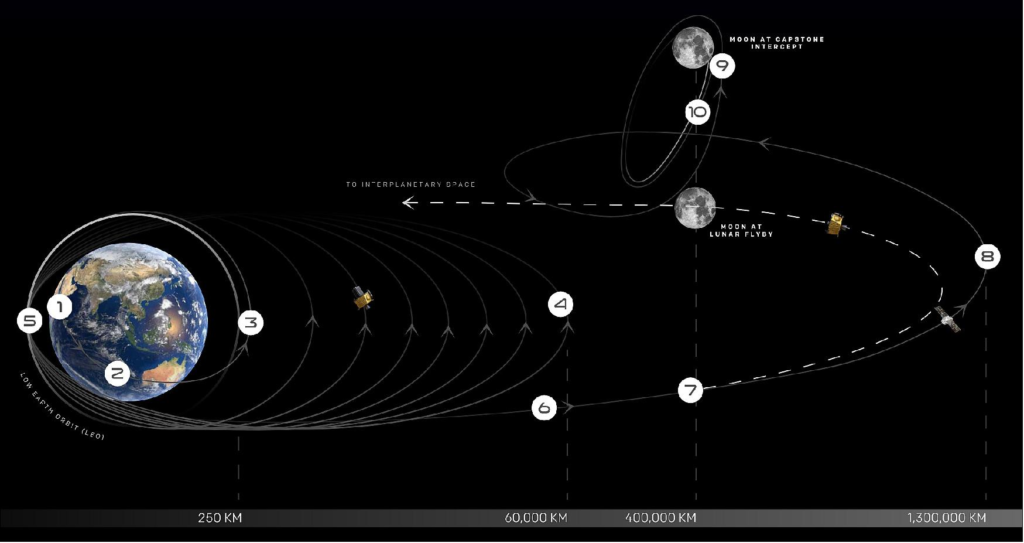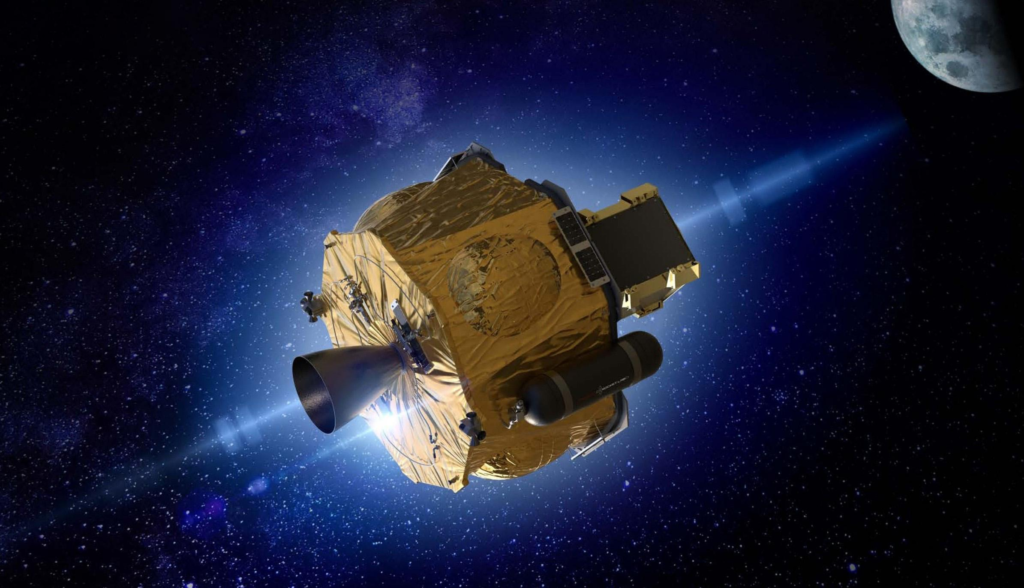
CAPSTONE Continues To Show Promising Results On Its Journey
The Moon is by no means an easy target for any sort of mission. Whether you are trying to land humans on the surface or place a satellite in its orbit, there will be a long list of challenges ahead of you. This being said, Artemis is well underway and NASA has ambitious plans for the future. This process not only includes returning humans to the surface but also setting up a lot of necessary infrastructure such as a Moon space station.
Before such a large project can be set up, NASA is working to learn more about a possible orbit that would provide many different benefits. Just over a week ago, we watched Rocket Lab launch Electron with CAPSTONE on top. After a few communications errors, CAPSTONE seems to be working well as it continues the long trip to the Moon.
If successful, CAPSTONE will not only demonstrate the capabilities of everyone involved but provide crucial information for the future of Gateway and landing humans back on the Moon. Here I will go more in-depth into the recent updates on CAPSTONE, what the future holds, and what to expect regarding Artemis, and more.
Recent Updates

Soon after CAPSTONE was released from Photon NASA discovered some issues with communication and the contracting the satellite. More specifically, during the commissioning of the CAPSTONE spacecraft, the Deep Space Network team noted inconsistent ranging data. While investigating this, the spacecraft operations team attempted to access diagnostic data on the spacecraft’s radio and sent an improperly formatted command that made the radio inoperable. The spacecraft fault detection system should have immediately rebooted the radio but did not because of a fault in the spacecraft flight software. Not long after, CAPSTONE’s autonomous flight software system eventually cleared the fault and brought the spacecraft back into communication with the ground, allowing the team to implement recovery procedures and begin commanding the spacecraft again.
While CAPSTONE was out of contact with Earth, the spacecraft autonomously maintained its orientation to keep its antenna pointed towards Earth and allow the solar panels to keep its battery charged. CAPSTONE also used its thrusters to perform a standard maneuver to dump excess momentum from its reaction wheels, which are internal wheels that help the spacecraft rotate and point itself. The mission operations team conducted CAPSTONE’s first trajectory correction maneuver at approximately 11:30 a.m. EDT on July 7th. Later that day, CAPSTONE successfully completed its first trajectory correction maneuver, which started at 11:30 a.m. EDT Thursday. This is the first in a series of thruster burns over the next few months to more accurately target CAPSTONE’s transfer orbit to the Moon. The maneuver lasted just over 11 minutes and changed the spacecraft’s velocity by about 45 miles per hour (about 20 meters per second). At that specific stage, CAPSTONE was about 289,000 miles from Earth, beyond the orbit of the Moon. CAPSTONE will loop back around and arrive to its lunar orbit, called a near rectilinear halo orbit, or NRHO, on November 13th. Advanced Space highlighted that this maneuver is the first statistical maneuver of the mission meaning it is designed to clean up expected dispersions from the launch vehicle injection and does not change the baseline transfer approach or timing of arrival at the Moon on November 13th. Operations on the Ballistic Lunar Transfer and in Earth-Moon three-body orbits (such as Near Rectilinear Halo Orbits) require precise maneuvers and knowledge of the spacecraft state (position and velocity). The CAPSTONE propulsion system was specifically designed and optimized for these precise maneuvers and the navigation system was built from the ground up to be efficient and scalable. All of this is supported by a uniquely qualified team of flight dynamics experts at Advanced Space with a specialized focus on operations in cislunar space and multi-body orbital operations. CAPSTONE will fly in the NRHO for at least six months to study the dynamics of the orbit, which is the same one intended for Gateway, a lunar space station for science and human exploration under Artemis.
Next, on July 9th, the team for NASA’s CAPSTONE mission decided to stand down from the trajectory correction maneuver scheduled for the day to perform additional analysis on the spacecraft’s performance. Trajectory correction maneuvers are thruster burns used to clean up expected variation in CAPSTONE’s orbit and more accurately target its path to the Moon. The maneuver scheduled for July 9th was to be part of CAPSTONE’s first series of trajectory corrections. CAPSTONE’s first trajectory correction maneuver on July 7 achieved about 90% of the objectives for this series of maneuvers.
Most recently, yesterday on July 12th, both Advanced Space and NASA provided more details on the progress of CAPSTONE. Here the spacecraft successfully completed its second trajectory correction maneuver starting at about 11:30 a.m. EDT Tuesday. CAPSTONE will perform several such maneuvers during its four-month-long journey to lunar orbit to refine its trajectory to the Moon, with the next one targeted for late July. CAPSTONE is taking a long but fuel-efficient route to the Moon, flying about 958,000 miles (1.54 million kilometers) from Earth before looping back around to its near rectilinear halo orbit. This spacecraft burn was relatively small as it consumed around 35 grams of fuel. The purpose of the maneuver completes the corrective actions of the spacecraft separation from the Lunar Photon – a necessary and routine step to ensure the transfer trajectory remains on track. Even though this was a small maneuver, this further validates the spacecraft design, which was optimized for precise orbital operations. They also pointed out that at the time of maneuver execution, the spacecraft was approximately 789,000km from the Earth ( about 22 times further than the GEO belt and around 405,000 km further than the Moon) and moving approximately 587 meters a second, or 1313 mph. This maneuver was much smaller than the first trajectory correction maneuver last Thursday. This is an intentional shift in the spacecraft commissioning, demonstrating a smaller, more graceful, and precise maneuver in preparation for the future NRHO stationkeeping operations. The apogee was raised from 1.47 million km to more than 1.48 million km during the burn.
CAPSTONE’s Plan

Now that we know some of the recent progress the spacecraft has been making, we can take a closer look at some of its next steps and how it plans to reach the Moon. The transfer is called a Ballistic Lunar Transfer, from injection by the launch vehicle it will travel to approximately 1.5 million km from the Earth. During the transfer, the spacecraft will take images using the on-board camera and will execute several maneuvers to correct for errors and target a precise orbit insertion at the Moon. This transfer approach has been used by spacecraft in the past and is likely to be used by many missions in the future. Advanced Space specializes in these highly dynamic orbit designs and operations which have enabled CAPSTONE and will support future programs as well.
As we know, the target orbit at the Moon for CAPSTONE is a Near Rectilinear Halo Orbit. Entering into this orbit will require a critical maneuver by the spacecraft. A critical maneuver means that it must be executed to achieve lunar orbit and there is very little margin for error. The same NRHO is the planned destination for NASA’s future lunar orbiting outpost known as Gateway. This unique orbit has many beneficial attributes to support sustainable architectures for exploring, developing, and settling the Moon. NRHOs are only marginally stable, so CAPSTONE will perform a small station-keeping maneuver about once a week. While in this orbit the CAPSTONE spacecraft and the team at Advanced Space will demonstrate operational performance and confirm simulations to support planning for future NASA missions. From here, demonstrating enabling technologies for future cislunar exploration and development is a top objective for the CAPSTONE mission. Throughout the mission, the spacecraft will be demonstrating foundational capabilities for new technologies. Specifically, the mission will mature the flight software for the Cislunar Autonomous Positioning System (CAPS). The mission will also be working closely with NASA’s Lunar Reconnaissance Orbiter (LRO) operations team to demonstrate a first-of-its-kind crosslink. This crosslink demonstration will see CAPSTONE send a ranging signal to LRO and for LRO to return it to CAPSTONE where it will be turned into a radiometric measurement and used in the CAPS software onboard to estimate the state of both spacecraft. This navigation approach will be the key to the future of cislunar operations where many more spacecraft will be operating at the Moon.
Conclusion
So far it has been very exciting keeping up with CAPSTONE and watching the initial launch with Rocket Lab. While there were some communication issues at the start, it seems that Advanced Space and NASA have figured them out and are continuing to work towards the Moon. We will have to wait and see how it progresses and the impact it has on the space industry.
